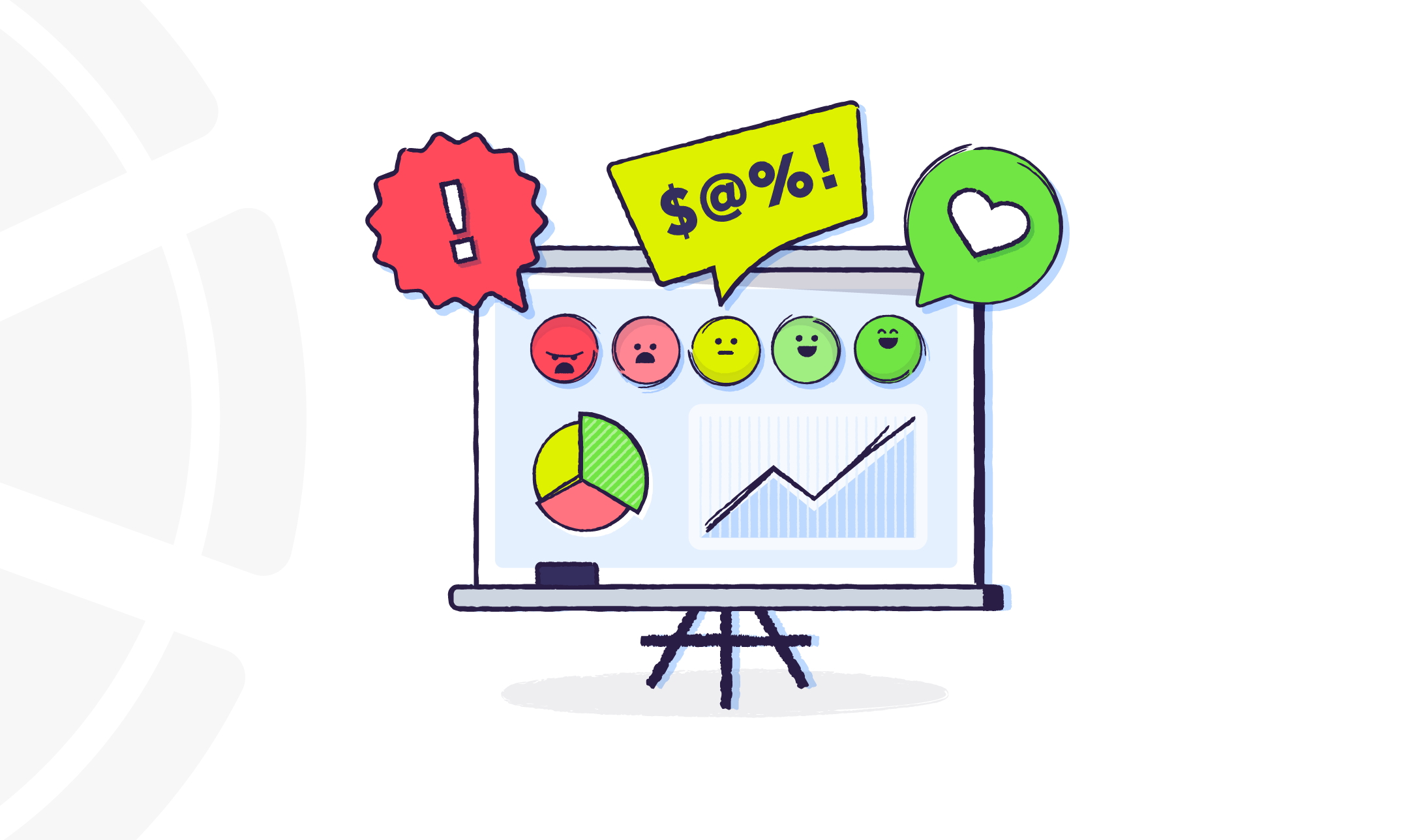Customer satisfaction score (CSAT) is a popular measure of customer satisfaction. It is typically a number between 1 and 5, with 5 being the highest score. You can get your CSAT through surveys and use the results to help your business improve customer satisfaction ratings. Customer satisfaction is essential for companies because it can affect loyalty and retention. Satisfied customers will continue doing business with a company, and they will also recommend the company to others. Therefore, improving customer satisfaction can lead to more customers and more revenue.
Related article: Improve and calculate customer retention rate
The most common method is asking customers to rate their satisfaction scores on a scale of 1 to 5. It can be done through surveys, either online or in person. Another way to calculate CSAT is to look at the customer churn rate. It is the % of customers who stop doing business with your company over a certain period. A lower churn rate means customers are generally satisfied and less likely to leave. CSAT is just one metric that businesses can use to measure customer satisfaction.
Other metrics include customer effort score (CES), and Net Promoter Score (NPS). CES measures how effortless it is for customers to do business with a company, while NPS measures how likely customers recommend a company to others. We will discuss these metrics in more detail later.
Improving customer satisfaction may feel like an uphill task, but there are a few things businesses can do.
- First, they can ensure that their employees provide good customer service. It includes being professional, friendly, helpful and quickly resolving customer issues.
- Second, businesses can make it easy for customers to contact them with questions or concerns. You can do this by providing multiple channels to serve customers, such as phone, email, and live chat, i.e., an omnichannel experience.
- Finally, businesses can stay updated on customer feedback and make changes accordingly. You may have to change the product or service or change how your employees interact with customers with the latest technology and use insights into customer behavior.
Benefits of measuring customer satisfaction
Customer satisfaction is one of the essential things for any business, especially in this customer-centric era. It’s the perfect tool to keep your customers happy and earn their loyalty. But how do you measure customer satisfaction? By finding out if your customers are happy and which area needs improvement. When you know how beneficial it is to measure customer satisfaction, you will use any methodology, tools, or technology to discover the true customer response to your products and services.
But first, the benefits:
- You will discover what your customers really think.
- You can use the data to ensure customers are happy
- The metrics will ensure that you know which areas need improvement
- The CSAT will help you improve customer loyalty and retention
- The CSAT scores will help measure your employees’ performance
The above benefits make it clear that it’s vital to measure customer satisfaction regularly to help spot any problems early and make changes proactively.
You can use customer surveys, mystery shoppers, customer interviews, or customer focus groups.
Customer surveys
Customer surveys are the most popular way to measure customer satisfaction. They’re easy to set up, and you can get useful information from them. You can use customer surveys to find out the following:
- What your customers think of your products or services
- What your customers think of your employees
- What your customers think of your prices
- What your customers think of your customer service
- What your customers think of your competition
Customer surveys can be done online, by phone, or in person. They can be long or short, depending on the type of information you need.
Mystery shoppers
Mystery shoppers are another popular way to measure customer satisfaction. Mystery shoppers act like regular customers, but they’re actually observing and taking notes on the service they receive. Mystery shoppers provide valuable information on:
- How your employees treat customers
- How well do your employees follow procedures
- How quickly your employees serve customers
- What your employees say to customers
- What do your employees do when there’s a problem

Customer interviews
Customer interviews are an excellent way to get in-depth information about your customers’ experiences (CX). You can use customer interviews to find out:
- How satisfied your customers are
- What do your customers like and don’t like
- What your customers think of your products or services
- What your customers think of your employees
- What your customers think of your competition
Customer interviews can be long or short, depending on what information you need, and you can conduct them over the phone or in person.
Customer focus groups will also fetch you in-depth information about your CX. In a focus group, customers discuss their experiences with your products or services. You can find out the following:
- How satisfied are your customers
- What do your customers like and don’t like
- What your customers think of your products or services
- What your customers think of your employees
- What your customers think of your competition
All of the above approaches can be made online, in person, or over the phone. While the questions and answers may overlap, they are still valid questions to ask, and the answers you find will allow you to fine-tune your process and improve areas the customer has found lacking.
There are so many benefits to measuring customer satisfaction that it is essential to implement the correct metrics to suit your business.
CSAT vs. Customer Effort Score (CES) vs. Net Promoter Score® (NPS)
The three different ways to measure customer satisfaction are:
- Customer Satisfaction Score (CSAT),
- Customer Effort Score (CES)
- Net Promoter Score® (NPS).
Here’s a quick overview of each:
CSAT
Customer Satisfaction Score (CSAT) measures how satisfied customers are with a product, service, or experience. It’s determined through surveys and helps gauge customer sentiment and identify areas for improvement. A high CSAT score signifies satisfaction, leading to retention and positive referrals. Monitoring CSAT helps businesses prioritize customer-centric improvements for ongoing enhancement.
The CSAT is a customer satisfaction metric that measures customers’ satisfaction with a company’s product or service. It is typically calculated by asking customers to rate their satisfaction levels on a scale of 1 – 5, with five being the highest.
The importance of customer satisfaction lies in its ability to foster customer loyalty, enhance brand reputation, and drive business growth.
CES
The CES is a customer effort metric that to measure the effort customers have to put forth to use a company’s product or service. It is typically calculated by asking customers to rate their effort on a scale of 1 – 5, with five being the highest.
NPS®
The NPS® is a metric for customer loyalty that measures how likely customers are to recommend a company’s product or service to others. It is typically calculated by asking customers to rate their likelihood of recommending on a scale of 1 – 10, with ten being the highest. It helps discover how the customer views your overall brand and is not limited to a single incident or purchase.

So, which of these customer satisfaction metrics is the best? That depends on what you’re looking to measure. CSAT is a good option if you’re interested in measuring customer satisfaction; CES to measure customer effort, and NPS to measure customer loyalty.
How to calculate customer satisfaction score
CSAT scores are typically used to track customer satisfaction over time and to compare satisfaction levels across different customer groups or channels. With different ways to calculate CSAT scores, the most common method is to take the percentage of customers who report being satisfied with their experience. For instance
To calculate CSAT scores, you must survey the customers and ask them to rate their satisfaction level on a scale from 1 – 5, with 5 being the highest possible score. You can then calculate the CSAT score by taking the percentage of respondents who rated their satisfaction as a 4 or 5. The two highest values on customer surveys are the most accurate predictor of customer loyalty. If you surveyed 100 customers and 60 of them rated their satisfaction level as a 4 or 5, your CSAT score would be 60%. It’s important to note that CSAT scores are only one measure of customer satisfaction.
Another metric is the NPS to measure the likelihood of customers recommending a company to others on a scale of 0-10. Businesses must ask their customers how likely they are to recommend the company on that same 0-10 scale. The responses are then divided into three categories:
- Promoters (9-10): These customers are very satisfied and likely to recommend the company to others.
- Passives (7-8): These customers are generally satisfied but may be less loyal or enthusiastic.
- Detractors (0-6): These customers are unhappy with the company and are unlikely to recommend it to others. NPS is the subtraction of % of detractors from the % of promoters.
So, if a company has a Promoter score of 70% and a Detractor score of 20%, its NPS would be 50 (70-20).
While understanding what CSAT score is and how valuable it is, you may also find it helpful to find answers to the below questions.
When and how to use customer satisfaction score surveys
A customer satisfaction score survey can be used anytime to measure customer satisfaction. However, it is most useful after a change has been made to a product or service, such as a new product launch, customer interaction, or onboarding. The simplest way is to send the survey to a randomly selected group of customers and ask them to rate their satisfaction with the product or service on a scale of 1 to 10. But ensuring that the surveys are sent timely is essential because you want to get their response when their interactions are fresh in their minds.

What can you measure with CSAT surveys?
You can use CSAT surveys to measure customer satisfaction, improve customer service, and increase your response rate. CSAT surveys also give you insights into their overall experience with customer service agents and reveal customer sentiment.
Related article: The importance of customer-focused culture
Final Note
Undoubtedly, CSAT scores are helpful regardless of industry or business size. It is valid across all B2B and B2C customers. Fortunately, all the steps to getting your CSAT can be driven by technology and automation, making it easy to gather information and analyze the data. Your business success depends on more than your product or service quality. It requires customers and their happiness in what you offer. Therefore, leveraging the available tools and software is in your best interests.



















